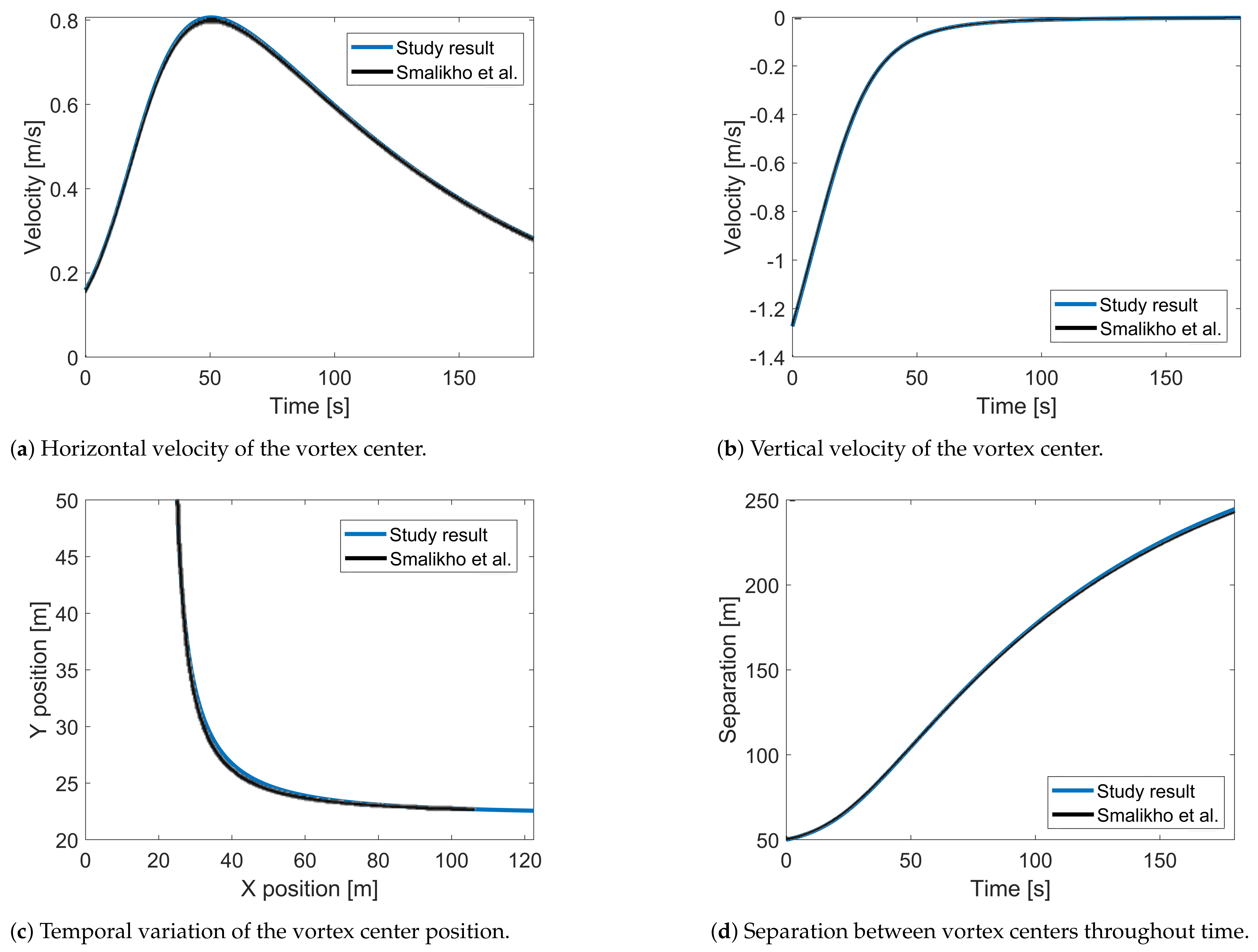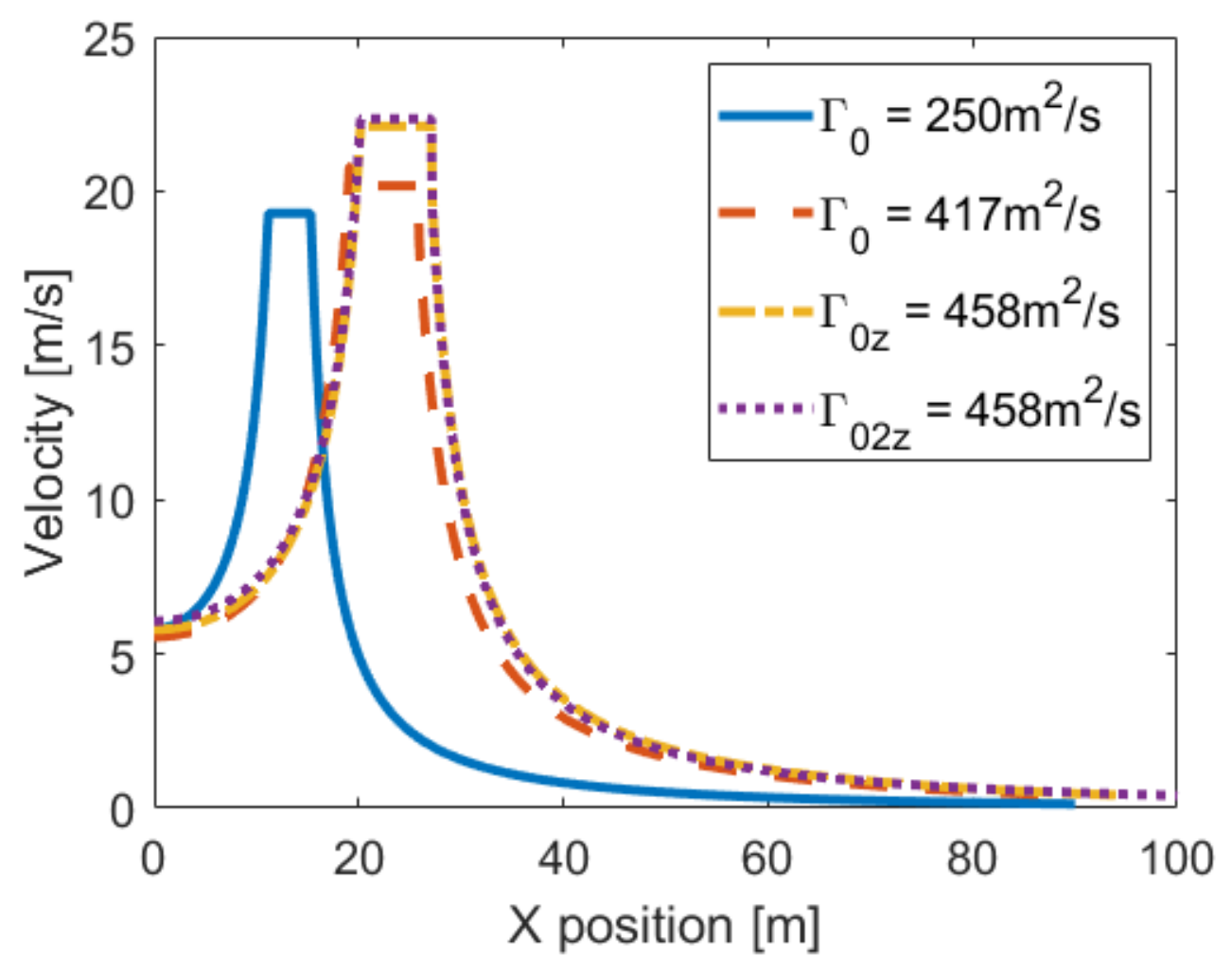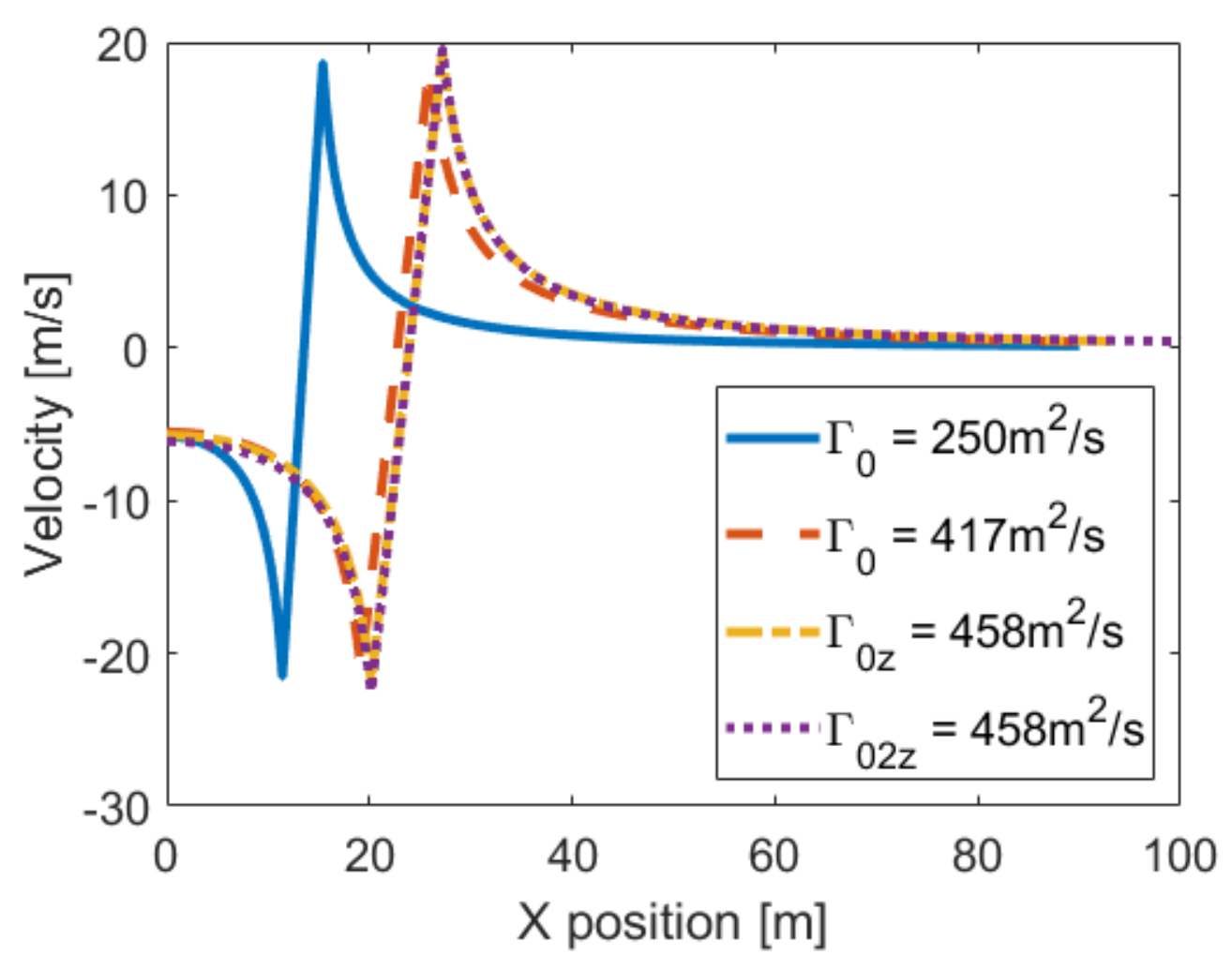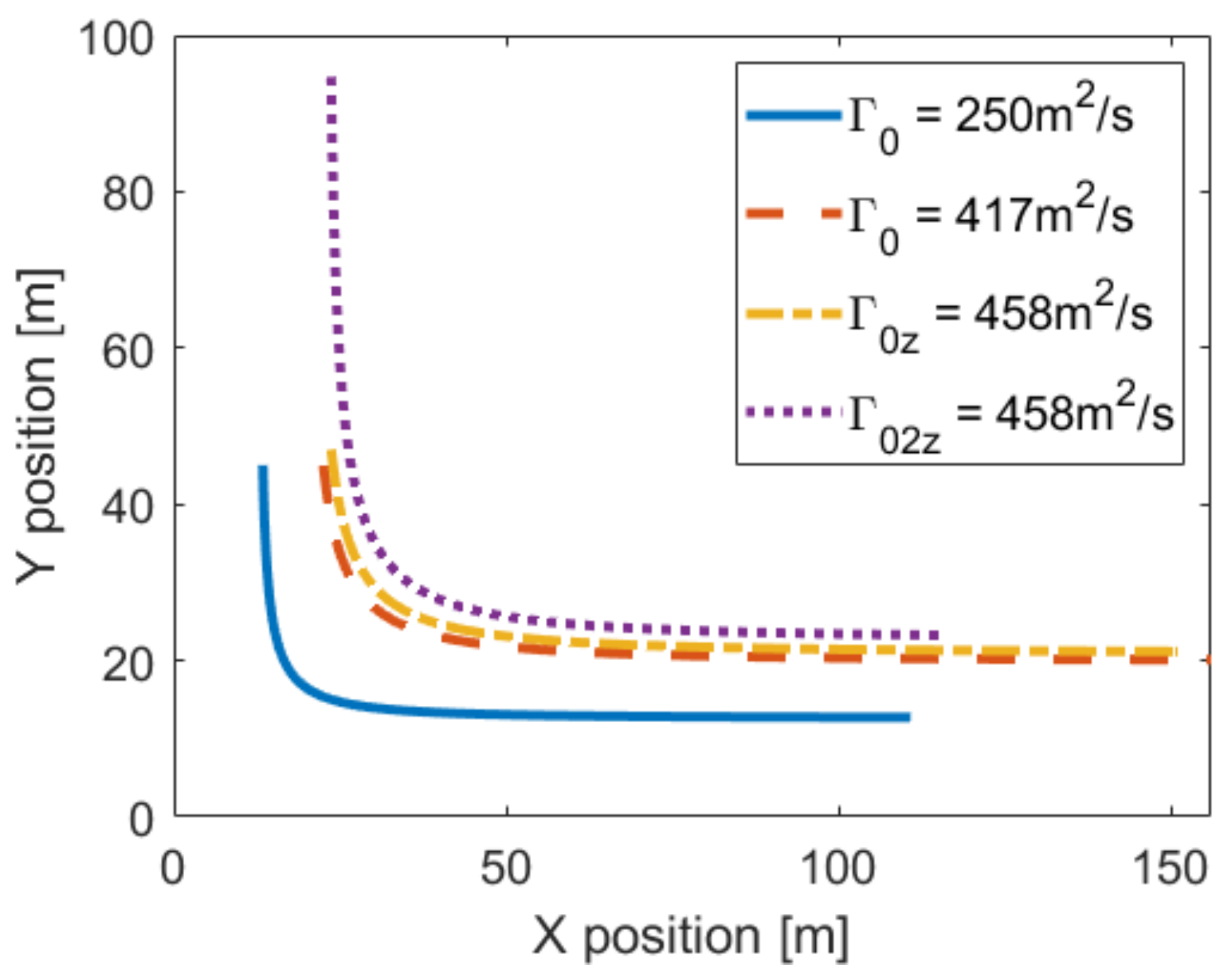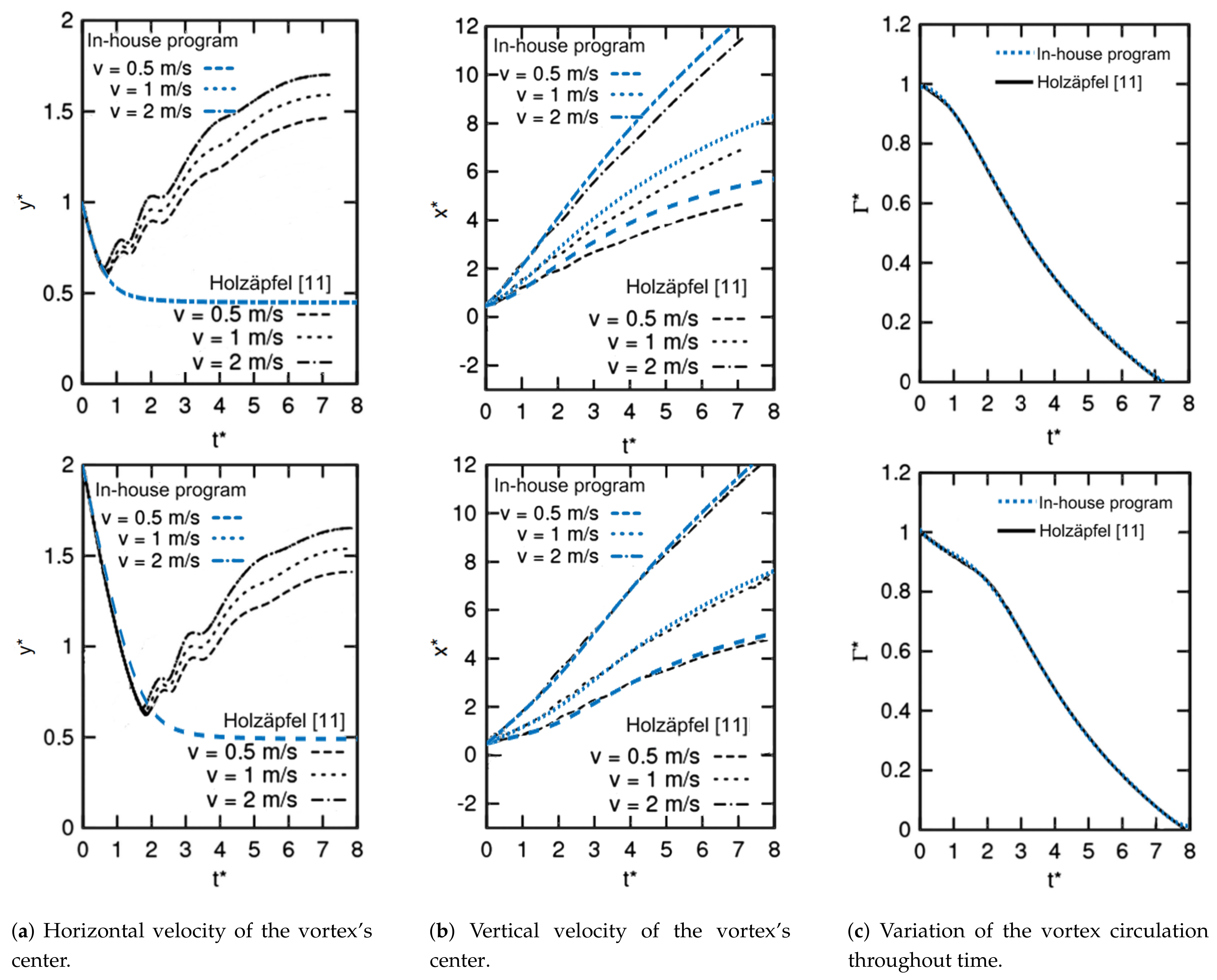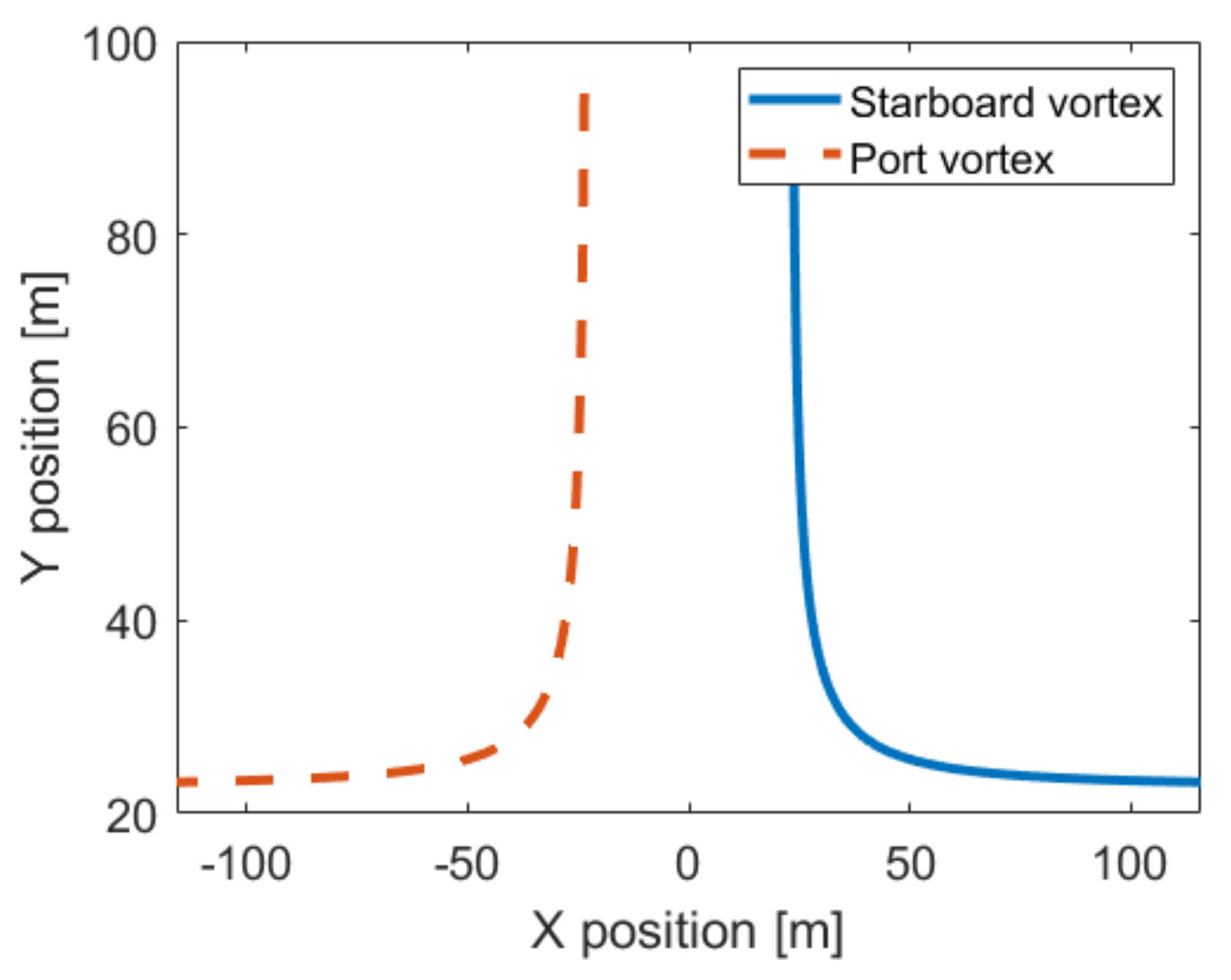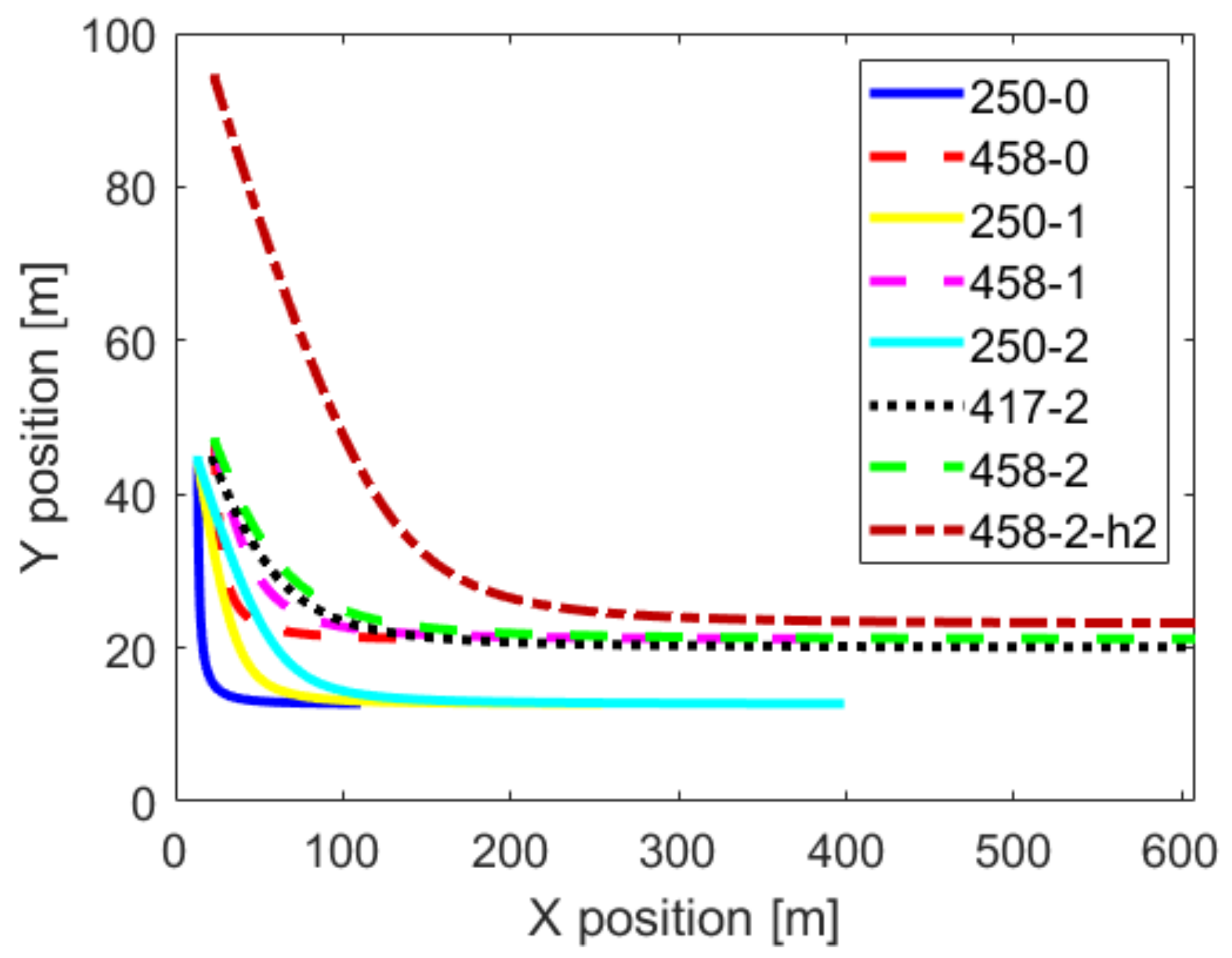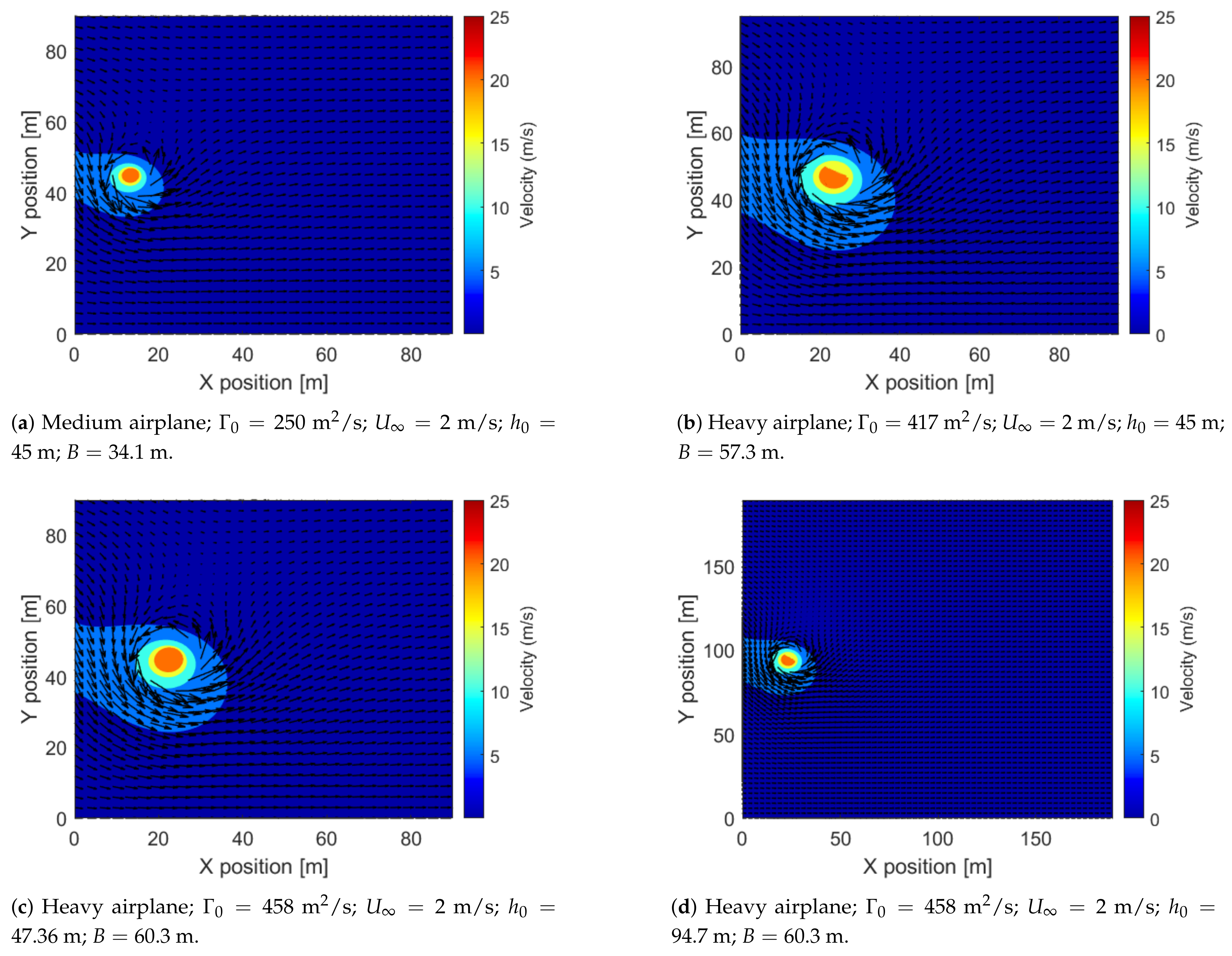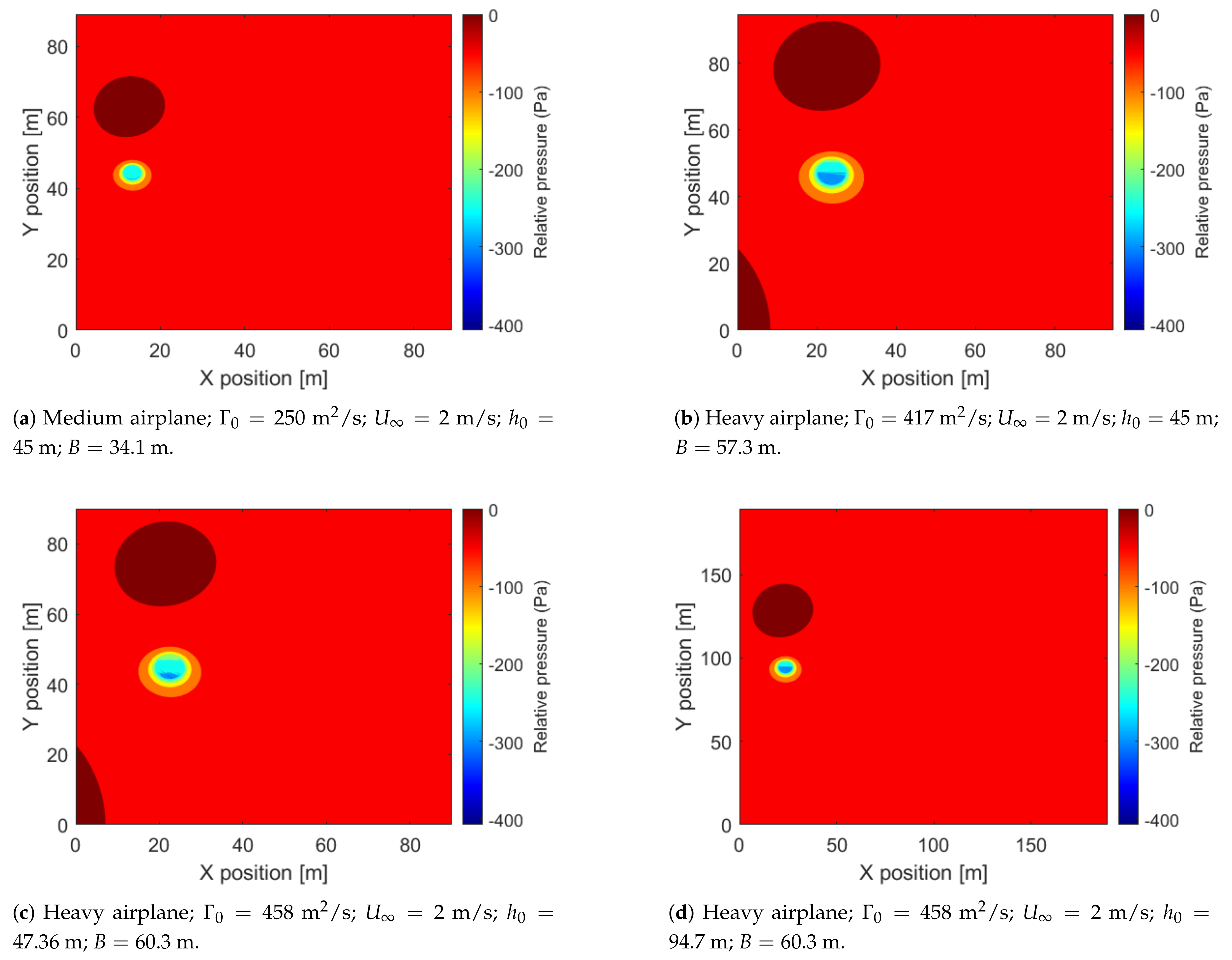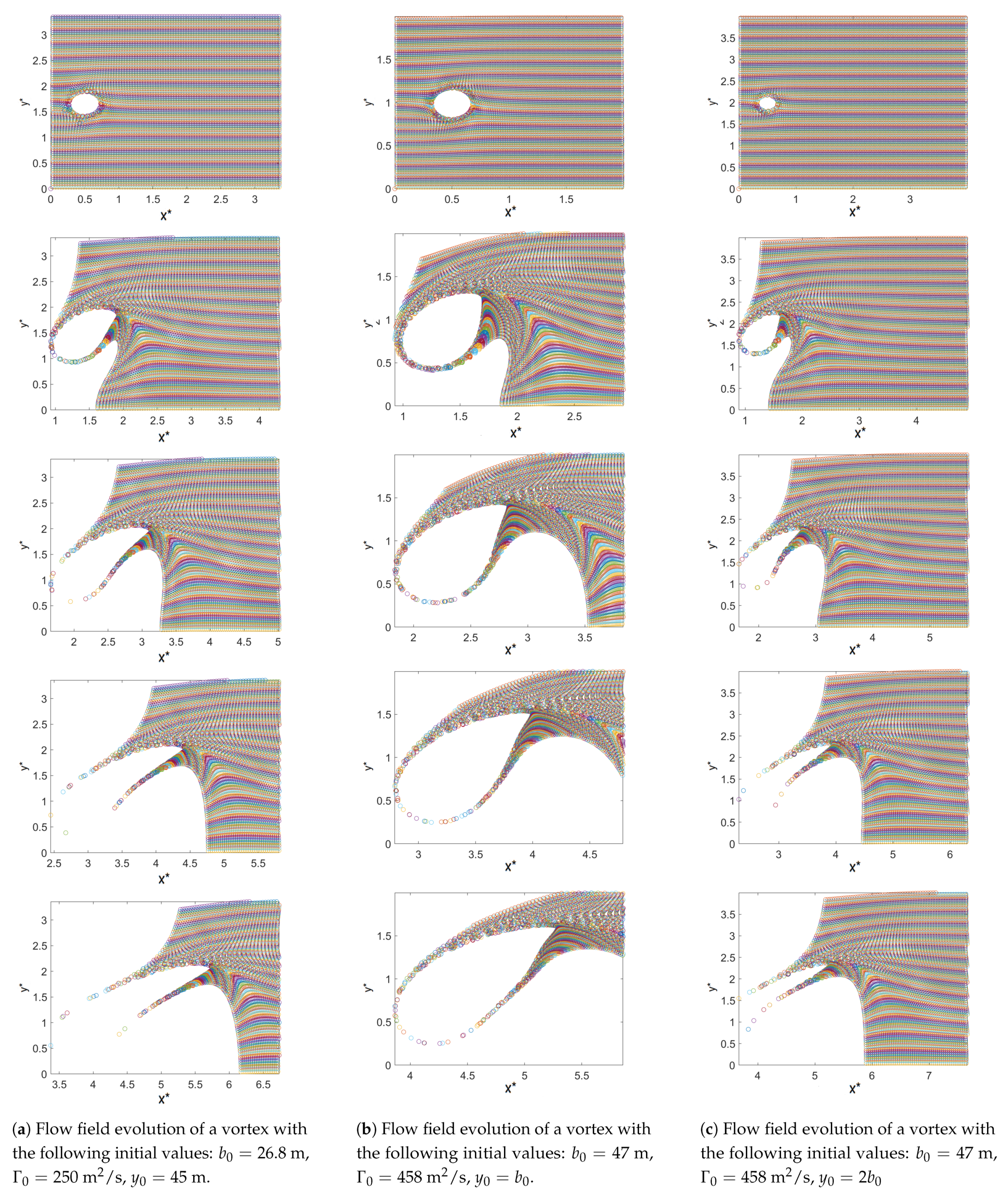4.1. Velocity Distribution
The potential flow equations presented in
Section 2 give the value of the physical variables at every point; thus the flow behavior over the entire domain due to the vortices’ presence can be obtained.
In order to see a detailed representation of the flow parameters, the figures only picture the results of the right-hand side of the domain, and then the flow values at the left-hand side are symmetric.
Figure 5, which was generated from Equations (
14) and (
15), represents the velocity field over the selected domain. Due to the circulation sign (positive in this case because the airplane’s wing generates lift), the velocity vectors point downwards near the vertical axis, where the distance between the two real vortices, the one shown in
Figure 5 and its symmetric, is at a minimum. At the outer part of the vortical structure, the velocity vector of the right-hand side vortex points upwards, but as the velocity vector induced from the symmetric vortex points downwards, the absolute value of the velocity magnitude is lower than at a location near the vertical coordinates’ axis.
As expected, and according to the definition of a free vortex, the fluid velocity magnitude increases near the center. Nevertheless, the core of the vortex is represented with constant velocity in
Figure 5 and
Figure 6. This has been done to better visualize the variables in the graphs.
The dimension of the vortices’ central core was retrieved from the definition introduced in Equation (
37), which is accepted as a general norm to avoid the asymptote that appears at the vortex center; this equation was used to obtain a better visualization of the variables’ change in
Figure 5 and
Figure 6. To calculate the central core dimension, one needs to know the initial value of the vortices’ position in the wingspan, which is presented by
; such a position is usually given as
. The parameter B stands for the wingspan and was initially defined in
Table 1 and
Table 3.
Figure 5 has been obtained by performing the domain’s discretization (where each cell has a size of
m), and calculating the velocity and the pressure at each cell. Then, specifically for
Figure 5, the streamline field was obtained with MATLAB’s specific function.
For the case of the medium airplane (
Figure 5a), the extent of the perturbation generated by the vortex is smaller when compared to other cases. This is due to its lower initial circulation.
On the other hand, in
Figure 5b,c, there are inappreciable changes, because both circulation and wingspan are very similar. However for
Figure 5d, although it has both initial conditions similar to the previous two figures, the initial height is double, and so its perturbation barely reaches the ground.
Figure 5 also shows the velocity field colored with the same scale for all circulations presented. It can be observed how the zone perturbed by the vortex increases as the circulation rises; notice as well that the velocity at the vortex’s central core is maximum. A particularity of the selected discretization of the domain can be clearly seen in
Figure 5a,b, where despite the circulation being higher in the case of
Figure 5b, it seems that the velocity at the central core of the medium airplane, shown
Figure 5a, is higher. This is because the central core radius in the second case is larger due to the higher dimensions of the airplane, as stated in Equation (
37). Almost identical phenomena can be seen in
Figure 5c.
In order to visualize the dimensions associated with the inner and outer zones and how fast the fluid velocity varies as it gets close to the vortex’s central core, the tangential velocity induced by each vortex along a horizontal axis passing through the vortex center is presented in
Figure 6, whose data were also retrieved from Equations (
14) and (
15). As the circulation increases, the maximum tangential velocity keeps rising. The vortex location along the abscissa axis is defined by the airplane dimensions: bigger airplanes have associated larger distances between vortices. (Note that the initial separation
is given by
, where B is the airplane’s wingspan).
Regardless of the circulation or the airplane dimensions, the zones where the velocity field suffers major variations are the left and the middle central core, as it is the location where the circulation has a bigger impact. This is because in the zone between the two vortices, the influence of the circulation sums up, and then the induced velocity generated by the two vortices has the same direction. As the circulation increases, the velocity in these zones rises, therefore generating the abovementioned differences.
In
Figure 7, we represent the vertical velocity along a horizontal axis situated at the generation height of the vortex. The curves represented in this figure present a similar behavior to the one explained in
Figure 6, but now the sense of the velocity vector can be clearly seen. The positive and negative peaks can be understood when considering the counter-clockwise rotation of the starboard vortex.
Based on Equations (
33)–(
36),
Figure 8 shows the temporal variation of the circulation. These temporal variations, as has already been explained, were retrieved from experimental measurements performed through LIDAR sensors, whose results are stated in the corresponding references established in
Table 5. This figure is presented to have an idea of the circulation evolution. In all cases, the temporal decay is minor at early times, but then a rapid phase decay occurs, which is usually given, at non-dimensional time
, where the circulation falls down rapidly. Finally, the beginning of the second phase normally coincides with the apparition of the vortex rebound on the vertical axis.
4.3. Vortex Displacement
Another feature that complements the created in-house program is the fact that the ideal trajectory of the vortex can be obtained based on Equations (
24) and (
25) combined with the time elapsed. In
Figure 10 it is seen that when the vortices are close to each other, the main displacement happens versus the Y-axis; this is because the vertical downwards velocity of its center is reasonably high, but after some time the only remaining velocity is the horizontal one, and then the vortex travels parallel to the ground.
The passage from a vertical movement to a horizontal one is due to the presence of the ground. In
Figure 10 one can see how the vortex with a higher initial height starts moving in the vertical coordinate and only changes its motion to the horizontal axis at the same point of the vortices whose initial circulation is the same, although their initial height is lower. It can therefore be concluded that the horizontal velocity is directly affected by the presence of the ground.
Finally, looking at the medium aircraft’s vortex, its motion along the Y-axis is bigger than for the other cases, because the two vortices generated by the airplane are closer together, meaning that its influence is higher, so the induced vertical velocity from one to the other will also be higher. This effect pushes the vortices further down and the horizontal movement starts at a smaller distance to the ground.
In
Figure 11 based on Equation (
25), although the initial height of the vortices of the different airplanes is nearly the same, it is observed how at the early stages of the study, the vortices’ vertical velocity displacement of the medium airplane is bigger (in absolute value) than the one of the larger airplanes. The acceleration is larger as well in the case of the medium airplane; notice that the slope of the velocity curve is steeper. This higher acceleration is because for the medium airplane the two vortices are closer than for larger ones. After about 60 s the vertical velocity of the vortices tends asymptotically to zero.
On the other hand, for the vortices generated at a higher altitude, the initial velocity is the highest among all (in absolute value). Additionally, as the time increases, its pendent becomes steeper and the vertical acceleration increases. Finally, as has been already shown in
Figure 10, the vertical velocity takes longer to become null in this case. Once the separation is high enough, the vertical velocity becomes 0, because the influence of the vortices between them becomes null.
When considering the temporal evolution of the horizontal velocity Equation (
24), see
Figure 12, it increases with time until reaching a maximum value and then steadily decreases tending to zero, providing the computational time is long enough. For the case of the medium airplane, the horizontal velocity does not decrease uniformly, this may be due to oscillations associated with the circulation, and then in
Figure 8 the circulation of this particular airplane is the one that decreases less steadily. Additionally, the peak of the airplane with circulation
is lower than the other ones; this is because, when this vortex arrives close to the ground, its circulation has hugely decreased, and thus the ground influence is lower and as a result the horizontal velocity will not be as high as the one associated with the other airplanes.
Such a velocity decrease appears reasonable; thus as the vortices separate, their mutual influence reduces. From
Figure 12, it is also observed that the horizontal velocity is directly affected by the presence of the ground. Because even though the vortex of the medium airplane has a lower circulation than the heavier airplane’s vortices, and at the initial time the circulation value is smaller, due to its faster approach to the ground, the horizontal acceleration during the initial time steps is higher in this case. In addition, this causes its peak to become like the other ones, despite the previously mentioned characteristics of the initial conditions.
Finally, from
Figure 12 it is also seen that the maximum value of the horizontal velocity keeps increasing with the circulation increase, providing that the initial height is the same. The peak of the horizontal velocity coincides with the time when the vertical velocity starts to be close to 0. Taking into account that the horizontal velocity is directly affected by the ground effect, this time characterizes the moment the vortex is closest to the ground, but also the two real vortices are still close enough to maintain an intense influence on each other. Notice that this time reduces as the circulation increases, due to the bigger mutual influence (in this case it can be hardly seen because both heavy airplanes with the same initial height have similar initial circulations). Notice that the medium airplane’s horizontal velocity arrives at its peak earlier than any other due to the closer position of the vortex to the ground.
In order to evaluate how long it takes until the vortices move away from the runway,
Figure 13 is used. As a consequence of the velocity values presented in (
Figure 11 and
Figure 12), it is observed that the rate of separation is smaller at the initial time because the vertical velocity has a bigger influence on the vortices’ displacement than the horizontal one.
The differences in the separation curves between the two heavy airplanes with the same initial height observed in
Figure 13 are almost negligible, and in fact they are due to the temporal variation of the circulation. A crossover point at nearly 180 s is observed and is due to the faster separation of the vortices with
m
/s than the ones of the other airplane. The separation evolution curve for the medium airplane seems to be parallel to the previous two in the early stages (due to its horizontal velocity and acceleration at early times), although after some time the curve tends to separate at a lower rate. The evolution for the final time steps seems to be more linear that the previous two. Finally, the vortices whose rate of separation is the slowest are the ones generated by the heavy airplane at a higher altitude, due to the previously commented upon characteristics regarding its horizontal velocity. The vortices do not separate until about 50 s and when they come close to the ground they start to move horizontally. As soon as the horizontal velocity reaches its maximum and starts to decrease, the rate of separation also decreases tending to an asymptotic value.
Taking into account that the widest runway measures 60 m, the vortices introduced in
Figure 13 should be out of the runway in less than 40 s (in the case of the medium airplane and the heavy airplanes with an initial height of 45 m), and in less than 70 s for the case of the vortices generated by a heavy airplane at an initial height of 97 m. Nevertheless, the time the following plane should wait until facing the runway should be longer than the one just described, as even though the centers of the vortices are expected to be outside the runway, their influence is expected to take longer to disappear; this point is discussed in
Section 4.7.
4.4. Vortex Movement and Circulation under Crosswind Conditions
Having analyzed the case without crosswind, the next step is to evaluate the effect of the crosswind on the vortical structures.
In order to validate the in-house program when crosswind is included, a comparison between the results obtained with the present mathematical model and the ones obtained by means of LIDAR measurements, taken from Holzäpfel [
11], is presented. The procedure to obtain the temporal variation of
is the same as the one explained in
Section 3. The equations employed to characterize the circulation decay are Equations (
33) and (
34).
As was previously explained, to generate
Figure 14, the figures belonging to Holzäpfel [
11] were extracted from the article and then modified to overlay the circulation given by the polynomial regression done in the in-house program.
The behavior of the vortices is almost the same, as seen in
Section 3. In the case of the horizontal evolution
, the values for
are very accurate. For the lower initial height
, the accuracy of the results is acceptable, although the position of the vortex center along the y* axis is slightly overestimated. This could be due to the absence of the boundary layer in the potential flow theory, meaning that the vortex motion is not affected by it. Finally, it seems that the error is lower for higher crosswind velocities,
.
On the other hand, when considering the vertical position evolution , the values are more accurate for the case of . But in both cases, the prediction becomes loose when the vortex rebound phenomena occur. One characteristic that must be noted is that the vertical position is independent of time in the in-house program—a fact that could not be taken as valid, because as increases, the vortex rebound is bigger.
In order to have yet another comparison, the data from article [
12] were used. There, the results of the in-house program, using a two-phase wake vortex decay circulation, are compared to a Bayesian Model Averaging (BMA) method. This method provides a slightly different circulation of decay throughout time (
Figure 15c), and thus it will be useful to compare the potential flow model to another decay method. The
evolution throughout time, in this case, fits the previously stated Equation (
35).
In
Figure 15a, the in-house program correctly predicts the behavior at early times, but after
it presents a deviation. Additionally, at approximately
it abandons the
envelope. To be noted is that for the potential flow model the vertical position of the vortex center is not affected.
In
Figure 15b, a comparison between the model presented by Körner et al. [
12] and the in-house program for different horizontal velocities is performed. In the figure it is observed that the experimental study has a perfect agreement with the mathematical model when considering a crosswind speed of
m/s. However, the agreement is also very good when the crosswind velocity is of
m/s. Both crosswind velocities are inside the
probability envelope, from which it can be concluded that the mathematical model presented is very accurate.
Before presenting the rest of the graphics that complete the analysis under crosswind conditions,
Table 6 must be introduced in order to understand the legend of the following figures.
Now, a significant characteristic to be kept in mind is the fact that regardless of the crosswind velocity, the separation between vortices remains the same. This is because potential flow is employed in both cases, with and without crosswind. Therefore, the crosswind will move the two vortices altogether but will not increase the separation between them. Nevertheless, this behavior is very similar to the real case, as is stated in reference [
13]. Then, the vortices will have the same separation as the one shown in
Figure 13, no matter which crosswind is applied. This is because as can be extracted from Equation (
14), once the subtraction between the velocity of the left and right vortices is done, the
value will disappear, and the rate of separation will be only a function of the circulation and the position of the vortices. The difference when adding up a
with respect to the unperturbed case can be seen when comparing
Figure 16 and
Figure 17. Both were obtained by combining Equations (
24), (
25) and (
34) with the elapsed time. In these two figures, the trajectory of the vortex pair can be observed, as well as how it is changed when crosswind appears, moving them further sideways with the wind’s direction. This movement is explained thanks to Equation (
24), as the only change due to the appearance of the crosswind is that the value of
is not 0 for any of the two vortices. Although in
Figure 17 it seems that the separation between vortices is lower than the one in
Figure 16, in reality, it is an effect produced by the horizontal scale of
Figure 17; then, when observing the position between the starboard (right side of the airplane) and the port (left side of the airplane) vortices in the last time step, the separation in both cases is the same (from, approximately, −115 to 115 m in
Figure 16, and from, approximately, 375 to 605 m in
Figure 17).
In addition, due to the crosswind effect, the velocity field suffers a modification, therefore affecting the pressure field, and then both fields have a direct relation as stated in Equations (
1) and (
28). The main characteristic in the relative pressure field over the ground (which is obtained by fixing the Y-axis position to 0 in Equation (
1) is that as the crosswind speed increases and the minimum pressure peak moves towards the left, see
Figure 18. It can also be seen that as
increases, the initial pressure drop keeps growing and the pressure recovery along the abscissa axis becomes smaller. In other words, the typical pressure recovery observed when there is no crosswind keeps disappearing as the crosswind effect is considered. In fact, the relative pressure in the right part of the domain remains negative when the crosswind effects are considered. This information is directly extracted from Equation (
1). It is also to be noticed that at a certain distance from the vortex’s central core, the pressure and flow fields are no longer influenced by the vortices’ effect; the only perturbation is given by the
, and pressure and flow fields will just depend on the crosswind.
Finally, looking at the different cases presented in
Figure 18, the case whose pressure drop is bigger is the one of the heavy airplane with a higher initial position; additionally, this peak is the one that has moved further to the right. Among the other airplanes, the biggest pressure drop is given by the medium airplane, because it gets closer to the ground and the pressure and velocity fields are particularly influenced by it.
Another parameter that is not affected by the crosswind is the temporal variation of the circulation; as it be seen from Equations (
33)–(
36), its value is independent from the crosswind velocity. This means that all of the cases with the same initial
will also have the same temporal variation. This is why
Figure 8 will stay true for all crosswind cases.
The temporal variation of the vortex position when the crosswind velocity effect is considered is shown in
Figure 19. It can be observed that as the crosswind velocity increases the vortex is further displaced sideways, but the final vertical position remains unchanged. This is a direct effect of the vertical and horizontal velocity, because even though the vertical velocity is not dependent on the crosswind, the horizontal is. This means that as the crosswind speed increases, the eccentricity of the hyperbola will be higher. From this figure it can also be extracted that the movement along the Y-axis is a function of the airplane’s dimension rather than of the circulation. As is seen in
Figure 11, the vertical velocity for the two different circulations of the heavy airplane (with the same initial height) is almost the same, and therefore the final Y-axis position in these cases will be also nearly the same. Yet, due to the temporal variation of
, the vortices with higher circulation will end their path in a slightly higher position in comparison with the ones with a lower circulation. This small change can be produced because the initial separation between vortices is lower for the case of lower circulation, which can generate a bigger interaction between them. Additionally, in the case that the initial height of the vortex is higher, the final position will also be slightly higher, compared to those vortices with the same initial circulation but initialized at a lower height. A lower circulation means that the vertical velocity induced by the vortices themselves is smaller, and thus they will move slower and stop the movement earlier. However, this last statement only applies to an airplane with the same dimensions, because as seen in
Figure 19, even though the circulation of the medium airplane is smaller than the one of the heavy airplane, the final position of its vortex is shorter, approximately 10 m less when compared with the position of the vortex generated by a heavier airplane.
Once the motion of the vortices is introduced, it is interesting to see how their velocity varies throughout time. First, as previously explained, the vertical velocity is independent of the crosswind, as can be seen from Equation (
25), and therefore the temporal variation will be the same as in the case without crosswind (
Figure 11). This is since the separation between vortices remains the same regardless of the crosswind velocity.
In the case of the horizontal velocity, the only change due to the appearance of the crosswind is that this value will be added up directly to the value already calculated supposing no crosswind, as can be observed from Equation (
14). It can be seen in
Figure 20 that as the circulation increases, the peak on the horizontal velocity becomes higher. The acceleration of the velocity on the X-axis is higher in the case of the medium airplane relative to the heavy ones. Even though at the initial time the velocity induced in this direction by the vortices themselves is almost 0, this particularly high acceleration is likely to be produced by the effect of the ground on the vortical structures. The behavior of the vortices generated by a heavy airplane at a higher altitude follows the same tendency as the case without crosswind, meaning that the peak is delayed with respect to the other models. Finally, for the medium airplane, the horizontal velocity becomes higher than the one of the heavy airplanes at approximately 110 s. This may be either due to the ground effect or due to a perturbation in the temporal variation of the circulation, which can be seen in
Figure 8.
Figure 21 represents the velocity field for different circulations and crosswind velocities. In general, when comparing
Figure 5 and
Figure 21, it is clearly seen how the velocity changes along the domain as the crosswind velocity increases, and the entire flow field is now more intense. Additionally, when crosswind is considered, there are zones where the velocity is null. In fact, for all of the cases studied with crosswind, the velocity is much higher below the vortex than above it; this is because below the vortex the velocity induced by the vortex and the velocity of the crosswind sum up (note the change of the light blue zone), and these two velocities flow in opposite directions above the vortices. Additionally, the area affected by the perturbed flow is wider and more irregular when crosswind is considered. Nevertheless, in both cases most of the domain remains poorly affected and the flow velocity in the nearest zone around the central core remains almost unaffected by the crosswind velocity. This is likely to be due to the large velocity field induced by the vortices, which is much higher in comparison to the induced velocity generated by the crosswind.
The main difference between
Figure 5c in respect to
Figure 5a,b resides in the intensity of the perturbation to the flow, which is lower in the case of a lower circulation. There is another difference that happens in the zone where the velocity is near 0. This zone moves from the quasi-central upper side to the upper right-hand part of the vortex as the circulation increases. Above this zone, the particles move to the right, as the speed of the vortices in this zone is not strong enough to overcome the crosswind. Within
Figure 5a,b just minor differences can be appreciated; nevertheless, the field’s intensity in the case of lower circulation seems to be higher, due to the fact that vortices are generated closer to each other, and the influence in the inner part of the vortex is a little bit higher, producing also higher velocities.
Finally, the differences due to the existence of crosswind are more visual in
Figure 21d, especially when compared to
Figure 5d. Now the domain is completely affected by the velocity field; in
Figure 5d, the influence of the vortex to the flow domain was rather small, due to its initial height. In
Figure 21c,d, the velocity field differences in the zone between the vertical axis and the vortex are almost inappreciable, and the ones that appear are likely to be due to the different position to the ground.
When considering the pressure field, see
Figure 22, the graphs greatly resemble the ones without crosswind; compare
Figure 9 and
Figure 22. Whenever the crosswind is considered, the pressure and flow fields lose their symmetry, the pressure at the entire field tends to decrease, and when looking at the central core of the vortices, the symmetry is also lost.
Comparing
Figure 22a,b, the main difference is that the zones with a pressure nearer to 0 reduce their area as the crosswind speed increases. Additionally, pressure symmetry around the central core is lost with the crosswind velocity increase, and the pressure below the vortical structure tends to reduce.
When comparing the figures with the same crosswind, it is seen that the smaller the initial circulation, the smaller the flow field area perturbed by the vortex. Additionally, the minimum pressure area is smaller when comparing the vortices generated by a medium airplane to the ones obtained from a heavy one (
Figure 22a in comparison to
Figure 22b,c). Additionally, the bubble over the vortex increases its area and displaces further up as the circulation increases.
Another aspect that can be noted is the fact that the center of the vortex experiences a harder depression as the circulation increases. Nevertheless, between similar circulations, the depression is a function of the distance between the two real vortices at its generation (see
Figure 22b,c). Finally, within
Figure 22c,d, the depression observed at the center of the vortex is higher for the one generated at a higher altitude.
4.5. Flow Field Evolution When No Crosswind Is Considered
After seeing different comparisons between models, it can be concluded that the two-phase wake vortex decay theory, implemented in the potential flow program, provides a good approach towards the evolution of the vortices. In order to visualize the temporal flow behavior around the near vortices domain,
Figure 23 was created, which shows the temporal evolution of the particles around the vortex’s central core for two different circulations, two different initial heights and when no crosswind is considered. Each one of the three different cases presented in this figure are characterized by the temporal decay of the vortices’ circulation defined by Equations (
33), (
34) and (
36). The analysis of the variation of its near flow field throughout time will be done until a nondimensional time of 2, which is the maximum time at which the in-house program is very accurate.
This figure clearly shows how the central core moves downwards near the ground while increasing the distance between the homologous core located on the left-hand side and not presented in the figure. It is also seen how the central core grows and changes its shape from the initial almost circular one to a nearly oval one after a time step equal to
. These two aspects are less intense for the case of the vortices generated at a higher altitude (see
Figure 23c) due to its greater distance from the ground. The same happens for
Figure 23a, but this is due to the fact that its nondimensional time is lower compared to the other ones; see
Table 5.
As the circulation increases, the central core grows and the perturbed flow area around the vortex becomes larger. In fact, the vortex evolution shows how the fluid particles tend to rotate together with the vortex. Initially, just the central core near the flow field follows this motion, but as time develops the entire flow domain keeps being affected by the rotation of the vortices’ central core. This figure also shows that until a non-dimensional time
, the vortices simply move downwards, and the central core maintains a nearly rounded shape. At the two final times presented (
and
), it is seen how the vortex center is displacing slightly downwards and considerably moving along the abscissa axis, changing the shape to an almost oval one. This deformation is mostly due to the presence of the ground. This situation is less exaggerated in
Figure 23c, because at the last time step the vortex is still arriving to the ground, and thus its lateral motion and core deformation are not clearly visible. The behavior of the vortex shown in the third column (
Figure 23c) is completely different than in the other two cases, because its generation height is higher. This means that its vertical displacement is longer, as is clearly seen in the corresponding set of figures. The horizontal velocity is lower compared to the other two cases, very likely due to the absence of the ground effect at early stages. Additionally, even though the vortex core increases its dimension, it maintains the round shape for all of the time steps, although at time step
its shape starts to be a little bit oval. To end the comparison, the quantity of particles disturbed is lower for this figure than that of
Figure 23a,b.
Finally, it needs to be kept in mind that although the temporal variation of circulation has been introduced based on experimental data,
Figure 23 may not still represent the real behavior of the vortex, due to the absence of viscosity in the mathematical model employed, which would attenuate the flow particles’ movement.
Some important details that need to be highlighted from
Figure 23 are: At the time step of
(first row), it is seen how, as the circulation raises, the dimension of the vortices’ central core increases. Additionally, the area of the perturbed flow field around the central core grows with the circulation, which is logical then the velocity induced is higher.
After
(second row), it is observed that the vortex of the medium airplane still maintains its axial position, while the heavy airplane vortices have slightly displaced towards the right. This is because of the horizontal velocity associated with the medium airplane, which is slower at the initial time steps than the one associated with the heavy ones;
Figure 12 clarifies this point.
At
(third row), the vortex of the medium airplane has a higher vertical speed (see also
Figure 11); this is due to the fact that the two vortices are closer than for larger airplanes, and therefore the mutual influence is stronger (although the highest vertical velocity is the one of the vortex generated at a higher altitude). Additionally, the shape of its central core starts to deform, a fact that can be more clearly visualized at
. The deformation of the flow field around the central core is now clear, becoming much more relevant at high circulations and as time increases. At this time step, it is also seen that once the vortices are near the ground, the horizontal central core displacement sharply rises, and the vortices quickly move away from each other. Based on
Figure 10, it seems the central core’s horizontal displacement speed increases as the vortex gets closer to the ground; in fact after about 60 s the vertical velocity becomes almost zero and the vortices’ movement is fully controlled by the horizontal one. This is the case of
Figure 23a,b, and in
Figure 23c the vertical movement will last until approximately 125 s after its generation. This fact can be seen in
Figure 11 and
Figure 12. The vortices’ central core and surrounding area’s deformation due to the ground effect can be clearly seen at this time.
4.6. Flow Field Evolution under Crosswind Conditions
The temporal flow evolution of the vortices’ central core and surrounding area for different crosswind speeds and circulations is presented in
Figure 24. Under crosswind conditions the entire flow-field also undergoes modifications. In order to see how it varies, the cases with a two-phase circulation temporary decay will be used in Equations (
33), (
34) and (
36). At the initial time steps the flow evolution with and without crosswind is very similar; compare
Figure 23 and
Figure 24. Once the time reaches
the differences start to be seen. At this time step, as the crosswind velocity increases, the perturbed flow field moves further to the right, and the area below the central core is particularly affected by the crosswind velocity where it generates a perturbed flow wedge that in the future times tends to wrap up the vortex central core. The central core flow field engulfment appears to be less relevant as the circulation increases; this is due to the higher flow field intensity associated with higher circulations.
At the time step of
, the central core wrapping up is clearly observed; the vortex’s central core starts suffering a clear deformation and elongation due to the stresses generated by the crosswind velocity. The deformation increases with the circulation decrease (taking into account that the deformation of the vortex generated by the medium airplane is similar to the other ones, but the time elapsed is lower, because
is lower, see
Table 5).
For the last two time steps ( and ), the vortices under a crosswind velocity of 2 m/s present a very noticeable deformation, stretching the vortices and further elongating them, and the flow area upstream is completely swept towards the downstream direction. For the three different cases presented it is clearly seen how the crosswind deeply deforms the center of the vortex, passing from a round shape to an elliptical one. This mentioned degeneration is bigger as the time increases, and the deformation due to the ground effect can hardly be seen, and thus it loses relevance. What is particularly relevant to mention at the final time step presented is that the vortical structures have moved sideways (along the abscissa axis). The medium airplane vortices have moved, approximately, 110 m, and the ones of the heavy airplanes have displaced by almost 200 and 190 m for the case of the vortices generated at a higher altitude. The value for the same models but without considering crosswind is, approximately, 30, 75 and 40 m, respectively.
Another aspect to be observed is the tendency of the particles to move together with the crosswind, instead of rotating together with the vortex, a characteristic that differs from the observations made for the case without crosswind (
Figure 23). Additionally, in all of the cases the particles of the right side of the represented domain move further sideways to the right than the ones in the left side. The same happens when comparing the top to the bottom of the domain.
One characteristic that has to be taken into account is that the boundary layer has not been represented in the near-ground domain, but in the real case could have some relevance for the crosswind movement, because the sideway movements of the particles touching the ground could generate new vortexes that could affect the motion of the principal ones.
Finally, the main difference between the cases with and without crosswind resides in noticing that the ground effect, which was particularly relevant in the cases without crosswind, becomes quite irrelevant as the crosswind velocity increases.
4.7. Time Reduction Analysis
In the actual regulations, the time between two consecutive airplanes is established by the ICAO. Both at take-off (
Table 7) and landing (
Table 8), see reference [
19], this time is a bit conservative, because it is based on a norm that has to be followed independently of the conditions under which the procedures are being designed. The aim of this section is to evaluate how much time could be saved if instead of generalizing and including all of the different conditions in the same rule, each case is studied independently with the conditions of each airport.
In order to determine when the vortices leave the runway domain,
Figure 25 was created, which for the different cases evaluated, shows the central core position along the abscissa axis over time. The equations characterizing the measured circulation decay were employed to generate this figure. The meaning of the legend presented in this figure is explained in
Table 9. In this figure the runway width is presented as two horizontal lines. The times extracted from this graphic will be compared with the ones of reference [
19], with the aim to see how much time can be reduced. The first thing to be observed is that the consideration of crosswind does not mean that the vortices will leave the runway earlier. Without crosswind, the vortices get away from the domain within a similar time to that when a crosswind velocity of 2 m/s is considered. On the other hand, the worst case is when the crosswind velocity is of 1 m/s; then for the A320 airplane (whose categorization is medium airplane), the vortices will leave the runway nearly 140 s after their formation. In the other case, for the heavy airplane (A340-300), the vortices leave the runway long after 180 s.
Continuing with
Figure 25, the next step is to extract the values from it. To round up the times, thus maintaining a small margin of error, an additional 15 s are added to the values retrieved from the graphic. As the widest runway is 60 m, it will be considered that the vortices leave it when the curve crosses the black line situated at 30 m. The results are presented in
Table 9, in which it is seen that as the crosswind speed increases, the vortices of the medium airplane will leave the runway before those of the heavy one.
The temporal variation of
in the case of the heavy airplane is the one stated in Equation (
33). For the medium airplane, the temporal variation corresponds to the one shown in Equation (
36). In both cases, as experimental data show (Reference [
11]), the temporal variation of
is not being affected by the crosswind. These temporal variations are the ones during the landing procedure.
In order to see which changes are produced by the introduction of the in-house program, the estimated time gain in percentage was calculated using Equation (
38), which compares the times obtained by the in-house program with the ones defined in reference [
19]. The results are presented in
Table 10, and show how much time could be saved if the present in-house program is implemented at the airports. In most of the cases studied the time reduction oscillates between 50% and 80%. The increase in time for the cases with
m/s is due to the strength of the crosswind not being high enough to move away the port vortex from the runway in a quick manner. For this case, the vortex speed is contrary to the crosswind velocity and the difference in velocity between them is small. As a result, the vortex needs to cross the whole runway moving slowly.
Finally, except for the case of m/s, the results should be taken as valid in the practical field, because the time elapsed does not widely exceed , and thus this stays inside the domain at which the in-house program is accurate, meaning that this application could be taken as reliable.
At this point it is interesting to highlight that when considering the methodology proposed by [
3], consistent in reducing the effect of fluid viscosity via sucking the boundary layer, or via causing the main vortex to split in many other small ones by putting horizontal plates in the runway (Holzäpfel et al. [
4]), the potential flow tool presented in this paper would be particularly useful, especially after considering its precision during the initial time steps, just before the vortex rebound starts. The tool presented in this paper needs to be seen as fast, widely applicable and accurate enough to estimate instantaneously the minimum time needed between two consecutive airplanes. The vortex behavior could be modeled even better if the secondary vortices’ evolution was also included in the in-house code. This would allow to estimate the rebound effect and greatly improve the temporary results of the in-house program. It has been stated that the in-house code generates good results provided that the experimental circulation temporal decay is known. To extensively use the in-house code, the circulation temporal decay measured from different airplanes in different airports and under different ambient conditions needs to be known. A possible methodology, among others, to avoid performing such a large amount of measurements, would be using an Artificial Neural Network (ANN), and then the circulation decay for conditions not measured could be extrapolated. If this information could be implemented in the presented in-house program, the minimum time between any two consecutive airplanes under any atmospheric conditions and for any airport could be determined.

